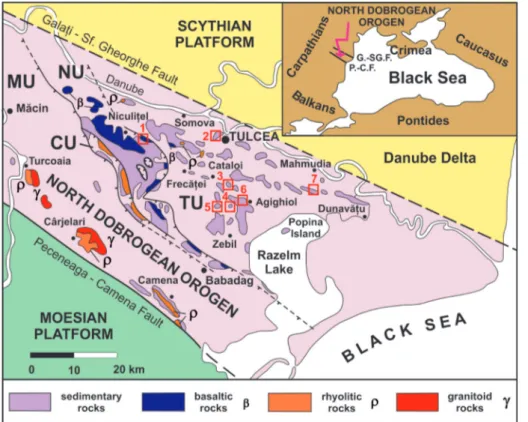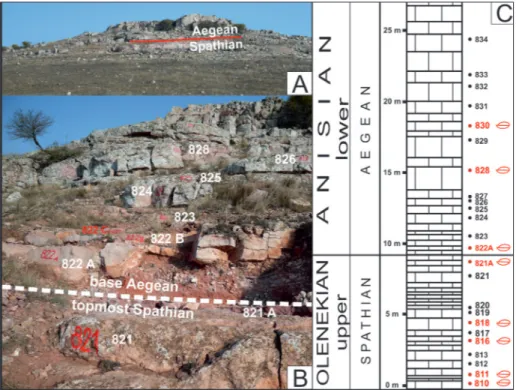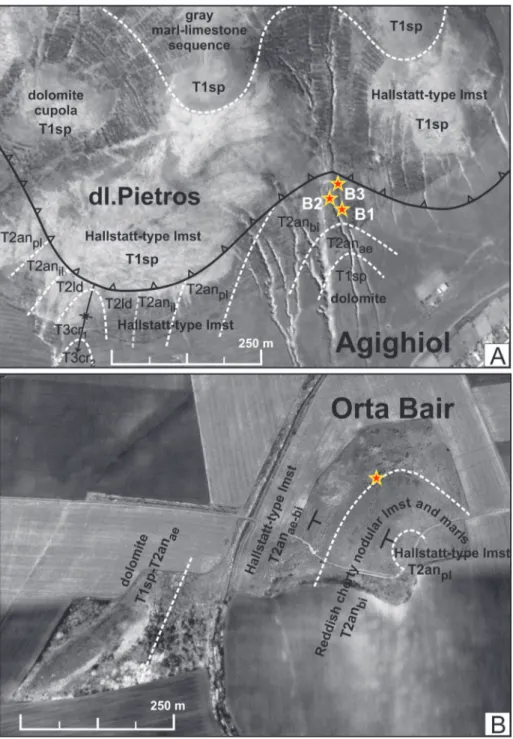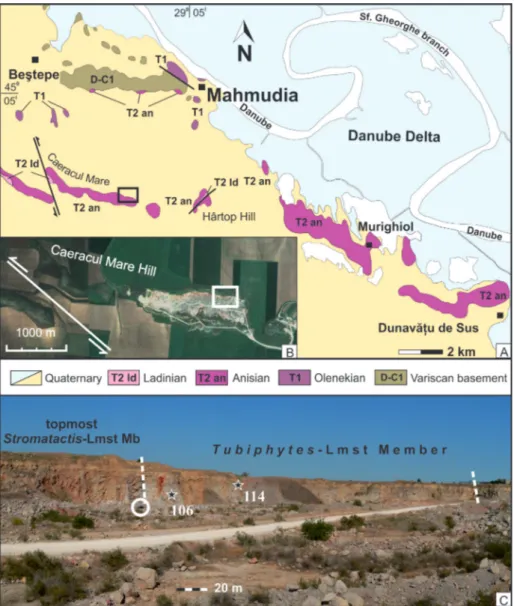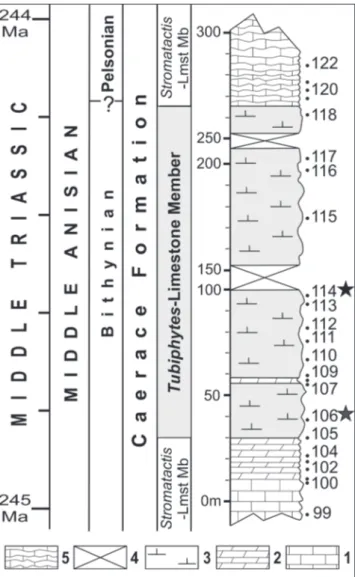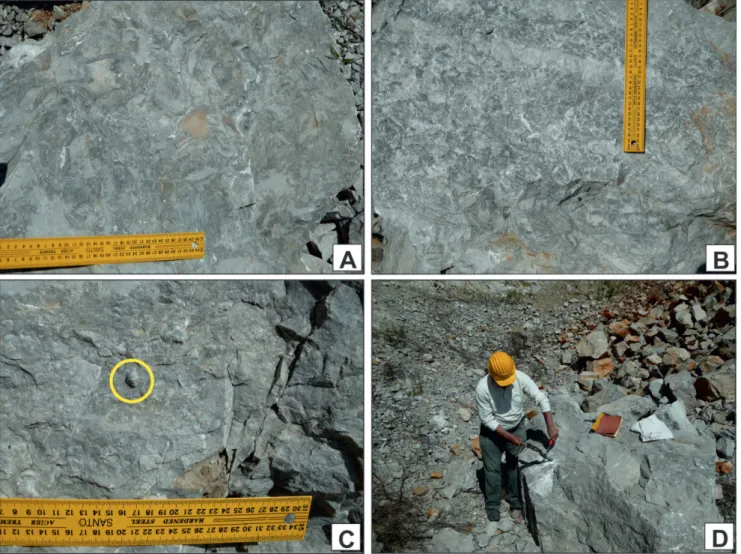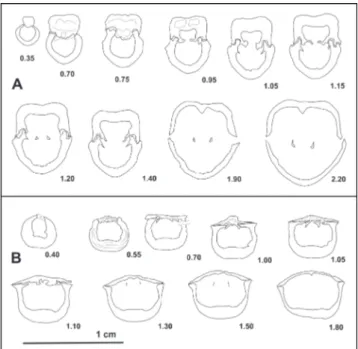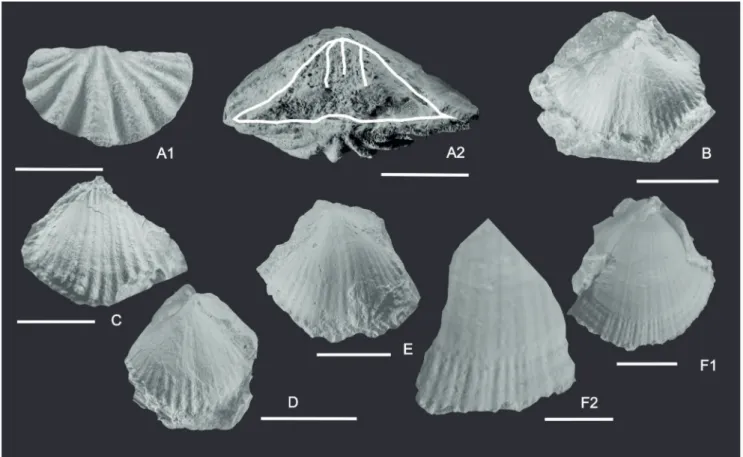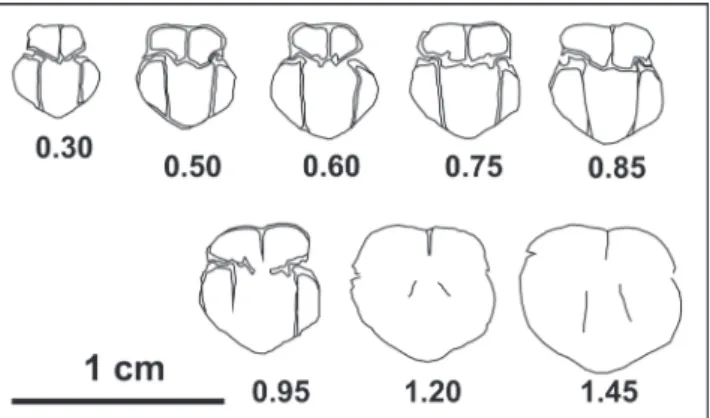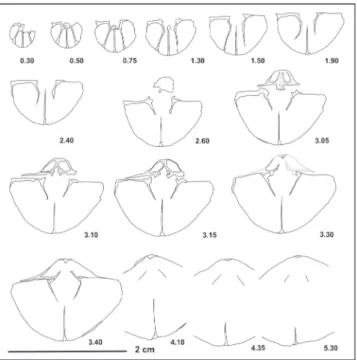UPPER SPATHIAN TO BITHYNIAN (LOWER TO MIDDLE TRIASSIC) BRACHIOPODS FROM NORTH DOBROGEA (ROMANIA)
EUGEN GRĂDINARU1 & MAURIZIO GAETANI†2
1Department of Doctoral School, Faculty of Geology and Geophysics, University of Bucharest, Bd. Bălcescu Nicolae 1 - 010041 Bucharest,
Romania. E-mail: [email protected]
2Dipartimento di Scienze della Terra “A. Desio”, Via Mangiagalli 34-20133 Milano, Italy.
To cite this article: Grădinaru E. & Gaetani M. (2019) - Upper Spathian to Bithynian (Lower to Middle Triassic) brachiopods from North Do-brogea (Romania). Riv. It. Paleontol. Strat., 125(1): 91-123.
Abstract. Brachiopods obtained from several Triassic localities in North Dobrogea, in Romania, are described. Upper Spathian and Aegean Hallstatt-type red limestones have been sampled in the Deşli Caira section, proposed as the GSSP for the base of the Anisian. The Bithynian brachiopods mostly originate from the Tubiphytes-microbial buildup in the Mahmudia quarry, and also from the Hallstatt-type limestones of Agighiol and Orta Bair. Their age estimates are supported by ammonoids collected from the same beds.
The upper Spathian and Aegean assemblages of Deşli Caira consist of four rhynchonellids, with one genus and two species newly described, Ortarhynchia petersi gen. n. sp. n. and Austriellula iordanae sp. n. The Bithynian assem-blages comprise the most diverse fauna, with 15 species, four species of which are newly described, Ortarhynchia petersi gen. n. sp. n., Piarorhynchella kittli sp. n., Ptychomentzelia dobrogeana sp. n. and P. simionescui sp. n. In the Tubiphytes facies of Mahmudia, the assemblage is numerically dominated by mentzeliids and dielasmatids, forming 84.8 % of the whole assemblage. Spiriferinids and rhynchonellids form the minor component. Instead, rhynchonellids prevail in the Hall-statt facies at Agighiol and Orta Bair.
The assemblages described here are hardly comparable with those of the western Tethys. The Bithynian assemblage is very different from its equivalent described from the substage stratotype in Turkey. In North Dobro-gea, the carbonate substrate and clear and agitated water supported an assemblage with high diversity. In contrast, in Bithynia, the brachiopod community dwelled on a softer and muddier substrate, with higher density and lower diver-sity. The locality of Aghdarband (Iran) also delivered Bithynian brachiopods, forming another different assemblage. The recovery and radiation of brachiopods after the P/T crisis is discussed in the framework of Palaeo-Tethyan palaeogeography, making comparisons with the South China localities.
Received: September 02, 2018; accepted: January 4, 2019
Keywords: Brachiopods; systematics; upper Spathian; Aegean; Bithynian; North Dobrogea.
I
ntroductIon(E. G
rădinaru)
Bounded on the north by the Danube Del-ta and rimmed on the east by the Black Sea, the North Dobrogea region is a fold-and-thrust belt, commonly named as the North Dobrogean Oro-gen (Săndulescu 1995; Visarion et al. 1990). It is located on the western tip of the Cimmerian Oro-genic System, which continues eastwards with the Mountainous Crimea, North Caucasus and extends furthermore to the Asian Cimmerides (Şengör 1984, 1986). The North Dobrogean Orogen is
tec-tonically bounded to the north by the Galaţi-Sfântul Gheorghe Fault and to the south by the Peceneaga-Camena Fault, which separate it from the Scyth-ian Platform on the north and from the MoesScyth-ian Platform on the south, respectively (Fig. 1). The North Dobrogean Orogen includes several tectonic units, namely the Măcin, Consul, Niculiţel and Tul-cea units, which are overthrust north-easterly (i.e. Săndulescu 1984; Visarion et al. 1990).
The Triassic sedimentary series that uncon-formably overlies a Variscan basement has the widest extension in the Tulcea Unit of the North Dobrogean Orogen, with basinal facies developed westwards in its inner part and a carbonate plat-form facies that extends in the mid-eastern part
(Grădinaru 1995, 2000). The carbonate platform was tectonically dissected by synsedimentary fault-ing into a complex network of pelagic swells and deep depressions. As a result, in the middle part of the Tulcea Unit, Middle and Upper Triassic deep-water sequences of reddish and greyish cherty, nodular limestones and varicoloured marly shales diachronously interfinger with thick sequences of Hallstatt-type thick-bedded limestones.
The present-day remote location of the North Dobrogean Triassic occurrences, placed outside of the Mediterranean Triassic, is currently interpreted as the result of the post-Triassic large-scale horizontal displacements of Tethyan terranes and the opening of the West Black Sea Basin (e.g. Grădinaru 1988; Okay et al. 1994; Banks & Robin-son 1997).
The Triassic development of North Dobro-gea is well known in the relevant literature for its Tethyan-type facies and richness in various groups of fossils (Arthaber 1906; Kittl 1908; Simionescu 1927; Tozer 1984; Grădinaru 1995, 2000). Ammo-noid faunas, alongside brachiopods, bivalves and gastropods, have been described in classic mono-graphs by Kittl (1908) and Simionescu (1910a-b, 1911, 1913a, 1925), with Agighiol (former Hagighi-ol) as the reference locality. More recent studies on the cephalopods, brachiopods, gastropods, bi-valves, conodonts, ostracods and foraminifers have
been done by Mirăuţă & Gheorghian (1975), Mi-răuţă & Iordan (1982), MiMi-răuţă et al. (1984, 1993), Crasquin-Soleau & Grădinaru (1996), Grădinaru & Sobolev (2006), Grădinaru et al. (2006, 2007), Or-chard et al. (2007), Sebe et al. (2013), Forel and Gră-dinaru (2018), and Nützel et al. (2018). The potenti-al for delivering vertebrate fossils (ichthyosaurs and coelacanths) is revealed by Simionescu (1913b) and Cavin & Grădinaru (2014), and Martin and Grădi-naru (work in progress).
Lastly, it is worth mentioning that the fir-st-ranked GSSP candidate for the base of the Ani-sian is represented by the Deşli Caira section, which is located in the Triassic classic area of Agighiol, in the Tulcea Unit (Grădinaru 2000; Grădinaru et al. 2006, 2007; Orchard et al. 2007; Ogg et al. 2016).
With special reference to the Triassic brachio-pods from North Dobrogea, data have been pub-lished by Peters (1867), Kittl (1908), Simionescu (1910a-b, 1911, 1913), Mirăuţă et al. (1984) and Ior-dan (1993).
For the Spathian to the Bithynian stratigraph-ic interval, on whstratigraph-ich the present paper is focused, brachiopods of this age have been mentioned only by Kittl (1908), Simionescu (1910a), Mirăuţă et al. (1984) and Iordan (1993).
Simionescu (1911) mentioned the presence of Spiriferina sp. and Rhynchonella sp. in the lower Spathian Tirolites beds from the Tulcea Veche
quar-Fig. 1 - Tectonic sketch map of the North Dobrogean Orogen with locations (red rectan-gles) of the studied brachio-pods and those published in previous references. Insert map shows the regional geological setting of the North Dobrogean Orogen. Abbreviations: MU - Măcin Unit, CU - Consul Unit, NU - Niculiţel Unit, TU - Tulcea Unit (modified after Grădinaru, 2000). 1 - Sarica, for the lower Spathian; 2 - Tulcea Veche, for the lower Spathian; 3 - Deşli Caira hill, for the upper Spathian-Aegean; 4 - Orta Bair hill, for the Bithynian; 5 - Man-dra, for the upper Spathian-Aegean; 6 - Agighiol hills, for the Bithynian); 7 - The Mahmudia quarry, for the Bithynian.
ry, but due to their fragmentary state these brachio-pods could not be assigned to definite species.
Kittl (1908) cited Spirigera marmorea var. au-riculata Bittner from Deşli Caira (Taşli, in Kittl), while, from Mandra, located westward of Agighiol, the same author cited Rhynchonella cf. arcula Bittner, Rhynchonella refractifrons cf. var. bosniaca Bittner, Spi-rigera marmorea var. auriculata Bittner, SpiSpi-rigera aff. S. balatonica Bittner, and Retzia sp. Also from Deşli Caira, Simionescu (1910a) described and illustrated a brachiopod fauna that includes Rhynchonella (Norel-la) kellneri Bittner, Spirigera marmorea var. auriculata Bittner, Rhynchonella aff. R. nux Suess, Rhynchonella sp. The brachiopods reported from Deşli Caira by Kittl (1908) and Simionescu (1910a) originate from Hallstatt-type limestones that, based on the present ammonoid and conodont biostratigraphic data, are latest Spathian to Aegean in age (Grădinaru et al. 2006, 2007; Orchard et al. 2007).
Mirăuţă et al. (1984) cited from the Sarica re-gion and illustrated Spirigerellina cfr. pygmea Dagys and Fletcherithyris margaritovi (Bittner), which in view of the associated conodonts, bivalves and the am-monite Tirolites cf. spinosus Mojsisovics, are dated as early Spathian.
Iordan (1993) illustrated a few brachiopods from the lower Spathian. Also, she quoted several species from the Anisian (Pelsonian and Illyrian) from different localities in the central and eastern part of the Tulcea Unit, but their ages are not
prop-erly constrained biostratigraphically. The taxonomic assignments have to be revised for most of the ma-terial.
Unfortunately, the repository of the materi-als cited by Kittl (1908), Mirăuţă et al. (1984) and Iordan (1993) has not been identified yet. Only a few specimens illustrated by Simionescu (1910a) are preserved in the Museum of Palaeontological Col-lections in the University “Alexandru Ioan Cuza” of Iaşi (fide Turculeţ & Brânzilă 2012, p. 90).
S
tratiGraphy(E. G
rădinaru)
The late Spathian to Bithynian brachiopods studied in the present paper originate from the successions exposed in the hill of Deşli Caira (up-per Spathian to Aegean) and in the regions of the Agighiol (Bithynian), Orta Bair (Bithynian), and Mahmudia (Bithynian) localities. The materials were collected by the first author (EG) over several de-cades.
Deşli Caira (Fig. 2A). The front of the
quar-ry (45°04’24.71” N, 28°48’04.92 ” E) exposes a total of 5 m of mixed reddish to light grey coloured lime-stones that grade upwards into brick-red coloured limestones at the top of the quarry face. Subordi-nate “Posidonia”-bearing, pale coquinoid limestones are interbedded with the Hallstatt-type limestones. The Olenekian-Anisian Boundary (OAB) is located Fig. 2 - A) General view of the Deşli
Caira hill from the south. B) The Spathian/Aegean boundary at the Deşli Caira hill, between samples 821A and 822A. C - Stratigraphic log for the Deşli Caira sec-tion, with the layers (in red color) that delivered the studied brachiopods.
just above the top of the quarry (Fig. 2B). Above the OAB, the basal part of the lower Anisian is made up almost exclusively of thick-bedded, brick-red co-loured Hallstatt-type limestones, with only rare in-tercalations of “Posidonia” bearing reddish coquin-oid limestones. The Hallstatt-type limestones are extensively bioturbated at some levels, with mottled aspects, and, in a few layers, they show condensed sedimentation features; small open-space features are present in the upper part of the section. The sequence yielded abundant ammonoids and fewer nautiloids of late Spathian to Aegean age. Other macrofaunas are poorly represented, with rare oc-currences of small-sized brachiopods, gastropods
and crinoids, and thin shelled bivalves at a few lev-els.
From the upper Spathian part, layers 810, 811, 816, and loose blocks from 816 to 821 (Fig. 2C) delivered three species (19 specimens): Norella kellneri Bittner, 1892, Austriellula iordanae sp. n., and Ortarhynchia petersi gen. n. sp. n.
From the Aegean part, layers 822A, 828 and 830 (Fig. 2C) contain three species (11 specimens): Austriellula iordanae sp. n., Ortarhynchia petersi gen. n. sp. n. and Costirhynchopsis sp. A.
The high-resolution ammonoid biostratigra-phy in the Deşli Caira section, which was achieved in the last decade due to bed-by-bed investigation Fig. 3 - Google Earth images (data © 2012 Digital Globe) show-ing the locations, by stars, of the studied Bithynian brachiopods at the hills of the Agighiol village, with B1, B2 and B3, and at the hill of Orta Bair.
Explanation: white dashed line for stratigraphic bound-ary; dark barbed line for overthrust, with barbs on the upthrown side.
Abbreviations: Lower Trias-sic, Spathian - T1sp; Middle Triassic, Anisian (Aegean, Bithynian, Pelsonian, Illy-rian) and Ladinian - T2anae, T2anbi, T2anpl, T2anil, T2la; Upper Triassic: T3cr1 - lower Carnian; T3cr2 - upper Car-nian.
(Grădinaru, work in progress), accurately demonstrates that the Spathian/Aegean boundary is placed a little higher in the section than had been previously estimated by Grădinaru et al. (2007). It is now placed between the levels 821 and 822A. The topmost part of the level 821 (821A) yields the uppermost Spathian ammonoid assemblage, inclu-ding Procarnites kokeni (Arthaber, 1908), Eogymnites arthaberi (Diener, 1915), Proptychitoides sp., Albani-tes sp., and others, whilst the level 822A yields a lowermost Aegean ammonoid assemblage, inclu-ding Aegeiceras ugra (Diener, 1895), Paracrochordiceras sp., Japonites sp., Stenopopanoceras sp., Lenotropites sp., and others. Aegeiceras ugra extends till layer 830.
Agighiol (Fig. 3A). Westward and near
the Agighiol village, the Bithynian brachiopods come from thick-bedded, variously coloured, cream to cream-pinkish and grey limestones ex-posed in deep ravines north of the hill Dealul Pietros. They were collected in three separate
outcrops, B1 (45°01’53.24” N, 28°51’47.57” E), B2 (45°01’51.82” N, 28°51’47.71” E), and B3 (45°01’53.20” N, 28°51’43.95” E), presently in-cluded in the Agighiol Natural Protection area. From Agighiol (18 specimens) originate Norella kellneri Bittner, 1892 and Ortarhynchia petersi gen. n. sp. n.
The Bithynian age of the brachiopods is properly documented by a rich assemblage of am-monoids, with species of Acrochordiceras, Platycuc-coceras, Intornites, Nevadisculites, Phyllocladiscites, Ussu-rites, Gymnites and other genera.
Orta Bair (Fig. 3B). At the hill of Orta Bair
(45°01’40.76” N, 28°48’31.84” E), located 4 km west of the Agighiol village, the Bithynian
bra-chiopods come from medium- to thick-bedded Hallstatt-type reddish limestones that are exposed on the western side of the hill. Three species are present. Norella kellneri Bittner, 1892, Austriellula iordanae sp. n. and Ortarhynchia petersi gen. n. sp. n., Fig. 4 - Geological map of the
Mahmudia region (A) show-ing the location of the Mahmudia quarry (black rectangle). B) Google Earth image (data © 2015 CNES/ Astrium) of the Mahmudia quarry (white rectangle). C) Photo of the northeastern corner in the Mahmudia quarry showing the section of the Tubiphytes-Limestone Member, and the strati-graphic levels of the studied Bithynian brachiopods (lay-ers 106 and 114). Circled car on the left side for scale.
originate from a single layer at the top of Hallstatt-type limestones at this locality (14 specimens). The associated ammonoid fauna includes species of Acrochordiceras, Hollandites, Robinsonites, Pseudodanubi-tes, UssuriPseudodanubi-tes, Gymnites and other Bithynian genera.
Mahmudia (Fig. 4). The studied
brachio-pods come from middle Anisian carbonate rocks that are exposed in a 1.5 km-long limestone quarry located in the Caeracul Mare hill area (45o03’12.41’’ N, 29o03’34.52’’ E), south of the village of Mahmudia. The Caerace Formation, which includes middle Anisian carbonate rocks, is divided into two distinct lithostratigraphic sub-units, the Stromatactis-Limestone Member and the Tubiphytes-Limestone Member. From the Stromatac-tis-Limestone Member only a single valve of
Ko-eveskallina sp. was collected. The microfacies and depositional environment have been described in detail by Popa et al. (2014). The brachiopods were collected almost exclusively from the Tubiphytes-Limestone Member, at two stratigraphic levels, lay-ers 106 and 114. The second level is by far the rich-est, the studied brachiopods being extracted from only 1.5 cubic meters of rock (Fig. 5). The strati-graphic section of the Tubiphytes-boundstones, about 250 m thick, which contained brachiopods is exposed in a vertical wall in the northeastern part of the Mahmudia quarry. As shown by Popa et al. (2014), the Tubiphytes-boundstones are a mas-sive carbonate buildup, lacking any visible bedding and showing a mixture of different carbonate fa-cies, with frequent, microbially-mediated cement crusts (Fig. 6). These are very fossiliferous in vari-ous groups of macroinvertebrates, including am-monoids, nautiloids, gastropods, brachiopods, bi-valves, sponges and crinoids, the gastropods and the bivalves being described by Nützel et al (2018) and Friesenbichler et al. (submitted). A very rich ostracod assemblage has been reported by Forel & Grădinaru (2018). When broken, the rock releases a pungent smell of rotten eggs. The high mass mortality ensured a high organic matter content to the carbonate sediment, and thus the reachness in nutrients of the Tubiphytes facies. The Bithyn-ian Tubiphytes-microbial facies from North Dobro-gea may be viewed as a chemosynthetically-driven oasis for various groups of organisms (Grădinaru 2017). The breakdown of organic matter by spe-cific chemosynthetic microbial consortia enabled the richness of nutrients for the superabundant biota in the Tubiphytes-microbial facies of North Dobrogea (Forel & Grădinaru 2018; Nützel et al. 2018; Friesenbichler et al. submitted).
The Middle Anisian Tubiphytes-microbial reef was firstly documented in North Dobrogea by Popa et al. (2014), and this is the only known reef of this kind in the western part of the Cim-meride Orogenic System. It is evidence, with other examples worldwide (e.g. Stanley 1988;
Senowbari-Daryan et al. 1993; Flügel 2002; Payne et al. 2006), of the recovery of carbonate production after the major biotic crisis at the Permian-Triassic bound-ary.
The early middle Anisian age (referred as the Bithynian substage in the standardized Geo-logic Time Scale 2016 published under the auspices Fig. 5 - Stratigraphic log for the Tubiphytes-Limestone Member in the
Mahmudia quarry showing the position of the layers 106 and 114 (main layer) of the studied Bithynian brachiopods. Lithologies: 1, thick-bedded limestone; 2, bedded grey lime-stone; 3, massive Tubiphytes-limestone; 4, section covered with quarried material; 5, bedded streaky grey limestone.
of the International Commission on Stratigraphy, e.g. Ogg et al. 2016; see also Shevyrev 1990; Mi-etto & Manfrin 1995) of the brachiopods is fully documented by a rich and diverse ammonoid as-semblage (Grădinaru, work in progress). The ammonoid assemblage of the Tubiphytes-buildup limestones includes Robinsonites sp., Alanites aff. A. visendus Shevyrev, 1968, Gymnites aff. G. tozeri Bu-cher, 1992, Megaphyllites prometheus Shevyrev, 1961, Longobarditoides solimani (Toula, 1896), Hollandites silberlingi Bucher, 1992, Caucasites inflatus Shevyrev, 1968, Acrochordiceras hyatti Meek, 1877, Ussurites aff. U. arthaberi (Welter, 1915), and others.
The ammonoid assemblage is similar to those of the lower middle Anisian (Bithynian) of the North-Western Caucasus (Shevyrev 1995) and the lower part of the Hyatti Zone in the middle Anisian of Western Nevada (Silberling & Nichols 1982; Bucher 1992; Monnet & Bucher 2006).
The brachiopod assemblage consists of 12 species (113 complete specimens and 34 incom-plete specimens): Piarorhynchella kittli sp. n., Co-stirhynchopsis sp. B, CoCo-stirhynchopsis sp. C, Punctospi-rella sp. ind., Dinarispira sp. ind., Koeveskallina sp. A, Koeveskallina sp. B, Ptychomentzelia dobrogeana sp. n., P. simionescui sp. n., Adygella sp. ind., Sulcatinella aff. S. incrassata (Bittner, 1890), and Rhaetina sp. ind.
Methods. The brachiopods have been
me-chanically cleaned and prepared. The internal structures were studied by serial sections, taking photographs and making peels at each step of grinding.
Repository of the material. The material
is housed in the Museum of the Laboratory of Palaeontology in the University of Bucharest, with Catalogue numbers LPB IIIb 800 to LPB IIIb 880. The numbers refer to the catalogue for Brachiopo-da from Romania.
Fig. 6 - Photos showing packages of rich-fossiliferous boundstone bearing microbially-mediated cement crusts (A, B and C) in the Tubiphytes-Limestone Member at stratigraphic level 106. Circled in C it is a rhynchonellid brachiopod. D) The first author extracting the brachio-pod from C.
S
yStEmaticpalaEontoloGy(m. G
aEtani)
The brachiopod fauna under study consists of 16 species. Nine of them are represented by a single or very few specimens, and not fit for full description and therefore left in open nomencla-ture. However, it was decided to illustrate all of the material collected in order to give a comprehensive view of the new fauna. The classifications of Man-ceñido & Owen (2001), Savage et al. in Williams et al. (2002), Carter in Williams et al. (2006), and Jin et al. in Williams et al. (2006) are followed in the systematic description.
Phylum BRACHIOPODA Duméril, 1806 Subphylum RHYNCHONELLIFORMEA
Williams, Carlson, Brunton, Holmer & Popov, 1996
Class rhynchonEllata Williams, Carlson,
Brunton, Holmer & Popov, 1996 Order Rhynchonellida Kuhn, 1949
Superfamily Norelloidea Ager, 1959 Family Norellidae Ager, 1959 Subfamily Norellinae Ager, 1959
Genus Norella Bittner, 1890 Type species: Norella refractifrons Bittner, 1890, p.315.
Norella kellneri Bittner, 1892
Fig. 7A, Pl. 1, figs A-D
1892 Rhynchonella (Norella) Kellneri spec. nov. Bittner: p. 25, pl. 3, figs 3-4.
1908 Rhynchonella (Norella) cf. Kellneri Bittner – Kittl: p. 482. 1910a Rhynchonella (Norella) Kellneri Bittner – Simionescu: p. 19, fig.
25, pl. 1, fig.18.
Material: Twelve specimens from the Bithynian of Agighiol, of which 10 are complete specimens: 3 figured specimens (LPB IIIb 800-802, Agighiol B2), 1 sectioned specimen (LPB IIIb 803, Agighiol B3), 1 complete specimen and 7 fragmentary specimens (LPB IIIb 804, AgighiolB2). Two complete specimens from the Bithynian of Orta Bair (LPB IIIb 805). One juvenile from the Aegean of Deşli Caira, layer 822A (LPB IIIb 806). Nine tiny complete specimens from the uppermost Spathian of Deşli Caira: layer 821, 1 figured specimen (LPB IIIb 807), layer 821, 2 additional specimens (LPB IIIb 808), layer 816, 6 specimens (LPB IIIb 809).
Description
External characters. Small norellid, subpentago-nal in outline, equi-biconvex, gently sulciplicate. A faint incision is present in the posterior dorsal valve in the juvenile specimens. Beak recurved, deltidial
plates not observed. Shell smooth.
Internal characters (Fig. 7A). Thick-shelled no-rellid, in which some details are obscured by crystal-lization. Ventral valve with rudimentary dental pla-tes, supporting stout teeth, deeply inserted into the sockets, forming a robust articulation. Muscle fields well incised in transverse section. Median septum absent in the dorsal valve, with short and feeble hin-ge plates. Deep sockets with lateral accessory ridhin-ges. Hamiform crura.
Dimensions (in mm)
Remarks. Norella kellneri Bittner, 1892 is
much smaller than all the other Norella species so far described. It differs from N. refractifrons, type
PLATE 1 Norella kellneri Bittner, 1892
Fig. A1-5 - specimen LPB IIIb 800. Dorsal, ventral, lateral, frontal, and posterior views, respectively. Agighiol B2, Bithynian. Fig. B1-5 - specimen LPB IIIb 801. Dorsal, ventral, lateral, frontal,
and posterior views, respectively Agighiol B2, Bithynian. Fig. C1-5 - specimen LPB IIIb 802. Dorsal, ventral, lateral, frontal,
and posterior views, respectively. Agighiol B2, Bithynian. Fig. D1-5 - specimen LPB IIIb 807. Dorsal, ventral, lateral,
fron-tal, and posterior views, respectively. Deşli Caira layer 821, Spathian.
Austriellula iordanae sp. n.
Fig. E1-5 - specimen LPB IIIb 810 holotype. Dorsal, ventral, lateral, frontal, and posterior views, respectively. Orta Bair, Bithyn-ian.
Fig. F1-5 - specimen LPB IIIb 812. Dorsal, ventral, lateral, frontal, and posterior views, respectively. Deşli Caira, layer 828, Ae-gean.
Fig. G1-5 - specimen LPB IIIb 815. Dorsal, ventral, lateral, fron-tal, and posterior views, respectively. Deşli Caira, layer 821, Spathian.
Scale bar 1 cm.
Specimen Length Width Thickness LPB IIIb 800 12.90 12.50 9.40 LPB IIIb 801 10.60 9.60 7.70 LPB IIIb 802 8.30 7.70 5.70 LPB IIIb 803 11.90 9.00 7.30 LPB IIIb 807 10.00 9.60 5.80 LPB IIIb 805/1 8.00 7.30 5.60 LPB IIIb 805/2 7.60 7.95 6.90
species of the genus, in the more elongate and in-flated shape, especially in the ventral valve, and has no faint plicae in the sinus. The species was firstly described from the Dinarids, without well-defined stratigraphic position. In North Dobrogea it was already described from Deşli Caira by Simionescu (1910a).
Occurrence. Deşli Caira, upper Spathian,
la-yer 816 and loose blocks from lala-yers 816 to 821; Deşli Caira, Aegean, layer 822A; Agighiol B2-B3 and Orta Bair, Bithynian.
Genus Austriellula Strand, 1928
Type species: Rhynchonella dilatata Suess, 1855; Dagys, 1974, p. 89, pl. 29, figs 8-9, text-fig. 57.
Austriellula iordanae sp. n.
Fig. 7B, Pl. 1, figs E-G
Derivation of name: Dedicated to Magdalena Iordan, who studied and illustrated the Triassic brachiopod fauna of Romania.
Type specimens: Holotype LPB IIIb 810), four paratypes (LPB IIIb 811), all from the Bithynian of Orta Bair.
Material: Other specimens: upper Spathian, Deşli Caira, la-PLATE 2
Ortarhynchia petersi gen. n. sp. n.
Fig. A1-5 - specimen LPB IIIb 819 holotype. Dorsal, ventral, lateral, frontal, and posterior views, respectively. Orta Bair, Bithynian. Fig. B1-5 - specimen LPB IIIb 820 paratype. Dorsal, ventral, lateral, frontal, and posterior views, respectively. Orta Bair, Bithynian. Fig. C1-5 - specimen LPB IIIb 821 paratype. Dorsal, ventral, lateral, frontal, and posterior views, respectively. Orta Bair, Bithynian. Fig. D1-5 - specimen LPB IIIb 822. Dorsal, ventral, lateral, frontal, and posterior views, respectively. Deşli Caira layer 821, Spathian. Fig. E - specimen LPB IIIb 820. Detail of the umbo and foramen. Orta Bair, Bithynian.
yer 810, 3 specimens (LPB IIIb 816), layer 811, 2 specimens (LPB IIIb 817), layer 821, 1 figured specimen (LPB IIIb 815), 1 additional specimen (LPB IIIb 818); Aegean, Deşli Caira, layer 828, 1 figured specimen (LPB IIIb 812), 1 sectioned specimen (LPB IIIb 813), and 5 additional specimens (LPB IIIb 814).
Diagnosis: Small sized shell, uniplicate, smooth. Thick shel-led, with dental plates fused inside the callus. Laminar crura.
Description
External characters. Very small sized shell, su-brounded in outline, with maximum thickness in the posterior part. Feebly uniplicate. Ventral valve for-ming ¾ of the total thickness. Dorsal valve almost flat and with a feeble depression in the posterior part of the valve in some specimens. Shell smooth, but with growth lines evident in some specimens.
Internal characters (Fig. 7B). Thick-shelled ven-tral valve, with deep muscle impression. Dental plates fused inside the callus; therefore, the teeth appear as directly supported by the shell wall and obliquely inserted in the sockets. Strong cardinal process, oblique hinge plates, with elevated inner socket ridge and a short median septum, poorly vi-sible inside the callosity of the shell. Laminar crura.
Dimensions (in mm)
Remarks. If the assignment to Austriellula is
correct, this species is the oldest representative so far known for the genus. With Austriellula it shares the general shape, the thick internal callosity and the deep muscle impression. The very small size could be linked to the “Lilliput effect,” which was typical of brachiopods during their recovery and radiation after the P/T mass extinction. Gaetani (2016) described Austriellula kavakensis (Arthaber, 1914) from the Bithynian of Gebze (Turkey). It is proportionally wider and less thick. Internally it has rudimentary dental plates. The genus is most wi-despread in the Upper Triassic, particularly in the Hallstatt facies (Siblik 1982), as it occurs in North Dobrogea.
Occurrence. Deşli Caira section, upper
Spathian, layers 810, 811, and loose blocks from lay-ers 816-821; Aegean, layer 828. Orta Bair, Bithynian.
Subfamily Paranorellininae Xu, 1990 Ortarhynchia gen. n.
Derivation of name: From the hill of Orta Bair in North Dobrogea.
Diagnosis: Equidimensional smooth brachiopod with small beak and foramen. Mostly rectimarginate. Thickened shell with callo-sity embedding both dental plates and septalium. No septum. Deeply incised muscle fields.
Content:. At present only the type species Ortarhynchia petersi gen. n. sp. n. is known. Upper Spathian and Anisian.
Ortarhynchia petersi gen. n. sp. n.
Fig. 8, Pl. 2, figs A-E
Derivation of name: In honour of Carl Ferdinand Peters, founder of the geological knowledge of North Dobrogea.
Type specimens: Holotype LPB IIIb 819, two figured pa-ratypes (LPBIIIb 820 and 821); four other papa-ratypes (LPB IIIb 825), all from Orta Bair, Bithynian.
Material: Other specimens: Bithynian, Agighiol B3, 1 speci-men (LPB IIIb 830), Orta Bair, 1 sectioned specispeci-men (LPB IIIb 823); Aegean, Deşli Caira, layer 822A, 7 specimens (LPB IIIb 829). Upper Spathian, Deşli Caira, layer 810, 1 specimen (LPB IIIb 822), layer 811, 1 specimen (LPB IIIb 826), layer 821, 1 sectioned speci-men (LPB IIIb 824), 1 specispeci-men (LPB IIIb 827), 1 specimen (LPB IIIb 828).
Description
External characters. Very small to small sized shell, subpentagonal to trigonal in outline, recti-marginate, smooth. The ventral valve has a small
Fig. 7 - A) Norella kellneri Bittner, 1892 – Serial sections of the spe-cimen LPB IIIb 803. Distance from the umbo in mm. Agighiol B3, Bithynian. B) Austriellula iordanae sp. n. Serial sections of the specimen LPB IIIb 813. Distance from the umbo in mm. Deşli Caira, layer 828, Aegean.
Specimen Length Width Thickness LPB IIIb 810 holotype 8.40 8.60 5.10 LPB IIIb 811/1 paratype 7.40 7.25 5.30 LPB IIIb 811/2 paratype 7.00 6.80 5.00 LPB IIIb 812 6.20 6.10 4.15 LPB IIIb 815 5.75 6.20 4.50 LPB IIIb 814 6.00 6.40 3.90 LPB IIIb 818 4.25 4.90 3.90
sub-erect umbo, with a small foramen, hardly vis-ible because of sediment infilling (Pl. 2, fig. E). Maximum thickness at mid-length.
Internal characters (Fig. 8). Very thick shell. In
the ventral valve, dental plates merged to lateral wall. Stout and short teeth, with small denticula. Deeply incised muscle field. Well developed cardinal process in the dorsal valve, high inner socket ridges. A po-tential septalium is embedded in the callosity of the thickened shell, from which the crural basis emerges forward. No septum. Short crura.
Dimensions (in mm)
Remarks. The size of the shell is double in
the Bithynian specimens vs the upper Spathian and Aegean specimens. The increase in size should be linked to the end of the “Lilliput effect”. No similar brachiopod seems to have been described in the Ole-nekian and Anisian.
Occurrence. Deşli Caira, upper Spathian,
lay-ers 810, 811 and 821; Aegean, layer 822A; Agighiol B3 and Orta Bair, Bithynian.
Subfamily Holcorhynchellinae Dagys, 1974 Genus Piarorhynchella Dagys, 1974
Type species: Piarorhynchella mangyshlakensis Dagys, 1974, p. 110, pl. 32, figs 8-10, text-fig. 75.
Piarorhynchella kittli sp. n.
Fig. 9, Pl. 3, figs A-E
Derivation of name: In honour of Ernst Kittl, who first extensively described the Triassic of North Dobrogea.
Type specimens: Holotype LPB IIIb 869; eight paratypes (LPB IIIb 831-835, LPB IIIb 870), all from Mahmudia, Bithynian.
Material: Other specimens: Bithynian, Mahmudia, 4 isolated valves (LPB IIIb 836).
Description
External characters. Small sized uniplicate rhyn-chonellid, wider than longer, strong sub-erect beak; maximum thickness at ¾ of the length, fold and sulcus starting at middle length. The dorsal valve has a significant depression in the early stage of on-togeny, then it is uniplicate with the fold showing a triangular contour. Fold slightly recumbent at the front. The ventral valve shows a low bulge poste-riorly, passing forward to a deep sulcus, with a trian-gular shape.
PLATE 3 Piarorhynchella kittli sp. n.
Fig. A1-5 - specimen LPB IIIb 869 holotype. Ventral, dorsal, lateral, frontal, and posterior views, respectively.
Fig. B1-5 - specimen LPB IIIb 831 paratype. Ventral, dorsal, lateral, frontal, and posterior views, respectively.
Fig. C1-5 - specimen LPB IIIb 832 paratype. Ventral, dorsal, lateral, frontal, and posterior views, respectively.
Fig. D1-5 - specimen LPB IIIb 833 paratype. Ventral, dorsal, lateral, frontal, and posterior views, respectively.
Fig. E1-5 - specimen LPB IIIb 834 paratype. Ventral, dorsal, lateral, frontal, and posterior views, respectively.
The Mahmudia quarry, Bithynian. Costirhynchopsis sp. A.
Fig. F1-4 - specimen LPB IIIb 837. Ventral, dorsal, lateral, and fron-tal views, respectively. Deşli Caira, layer 830, Aegean. Costirhynchopsis sp. B.
Fig. G1-3 - specimen LPB IIIb 838. Ventral, lateral and frontal views, respectively.
The Mahmudia quarry, Bithynian. Costirhynchopsis sp. C.
Fig. H1-5 - specimen LPB IIIb 873. Ventral, dorsal, lateral, frontal and posterior views, respectively.
The Mahmudia quarry, Bithynian. Scale bar 1 cm.
Fig. 8 - Ortarhynchia petersi gen. n. sp. n. Serial sections of the speci-men LPB IIIb 823. Distance from the umbo in mm. Orta Bair, Bithynian.
Specimen Length Width Thickness LPB IIIb 819 holotype 13.05 13.60 6.90 LPB IIIb 820 paratype 11.35 11.60 4.40 LPB IIIb 821 paratype 11.70 10.30 5.55 LPB IIIb 822 9.60 10.00 4.30 LPB IIIb 824 9.20 9.10 3.90 LPB IIIb 826 8.10 8.00 3.40 LPB IIIb 827 8.90 9.30 4.60 LPB IIIb 828 8.30 8.90 3.90 LPB IIIb 829 6.90 6.30 3.30 LPB IIIb 829 5.90 6.00 3.00 LPB IIIb 829 5.20 5.60 2.30 LPB IIIb 829 5.90 6.00 3.20 LPB IIIb 830 10.90 10.30 6.65
Shell smooth in the posterior part, then with rounded costae in the half-anterior part, 2/3 in the middle, 3/2 on the flanks. In some specimens, especially juvenile, the surface is almost smooth, with indentation present only along the frontal commissure. Peculiar is the tendency to have an asymmetrical development or to duplicate the me-dian costae.
Internal characters (Fig. 9). Heavy recrystalliza-tion prevents accurate descriprecrystalliza-tions. Dental plates, septalium, and median short septum are recogni-zed.
Dimensions (in mm)
PLATE 4 Punctospirella sp. ind.
Fig. A1-2 - specimen LPB IIIb 839. Dorsal view and posterior views, with traced dental plates, respectively. The Mahmudia quarry, Bithynian.
? Dinarispira sp. ind.
Fig. B - specimen LPB IIIb 840. Ventral view. Fig. C - specimen LPB IIIb 841. Ventral view. The Mahmudia quarry, Bithynian.
Koeveskallina sp. A
Fig. D - specimen LPB IIIb 842. Ventral view. Fig. E - specimen LPB IIIb 843. Ventral view. The Mahmudia quarry, Bithynian.
Koeveskallina sp. B
Fig. F1-2 - specimen LPB IIIb 846. Ventral view and magnification of the ornamentation with the dichotomy of the costae. The Mahmudia quarry, Bithynian.
Scale bar 1 cm.
Specimen Length Width Thickness LPB IIIb 869 holotype 11.40 13.50 9.30 LPB IIIb 831 paratype 9.90 10.50 7.30 LPB IIIb 832 paratype 10.30 12.70 9.20 LPB IIIb 833 paratype 13.50 13.70 7.60 LPB IIIb 834 paratype 13.60 16.30 9.50 LPB IIIb 835 paratype 13.20 14.80 10.10 LPB IIIb 870/1 9.70 10.90 6.65 LPB IIIb 870/2 11.80 11.90 9.55 LPB IIIb 870/3 13.15 15.90 10.20
Remarks. The North Dobrogea specimens
have some characters of Piarorhynchella and others approach those of Holcorhynchella. If compared with other species of Piarorhynchella, P. kittli sp. n. has the general shape, wider than longer, and the costae. From P. mangyshlakensis Dagys, 1974 it differs in the dimensions, the presence of a depressed area in the posterior part of the dorsal valve, and the irregu-larity of the median costae. The species from the Spathian of Mangyshlak is probably still under the “Lilliput “effect (Zakharov & Popov 2014). From the genus Holcorhynchella and its numerous species from Dalmatia, P. kittli sp. n. differs in the wider contour, higher number of costae and the wider, deep sulcus.
Occurrence. The Mahmudia quarry,
Tu-biphytes-boundstone, layer 114, Bithynian.
Superfamily Hemithyridoidea Rzhonsnitskaya, 1956 Family Cyclothyrididae Makridin, 1955
Genus Costirhynchopsis Dagys, 1977
Type species: Costirhynchia spatiosa Dagys, 1974, p.106, pl. 31, fig. 10, text-fig.69.
Remarks. Under this heading, I report three
specimens of costate rhynchonellids, different from each other, for which the actual species attribution is doubtful.
Costirhynchopsis sp. A
Pl. 3, figs F1-4
Material. One almost complete specimen (LPB IIIb 837).
Description
External characters. Small biconvex
unipli-cate shell, with sub-pentagonal outline forming an apron. Fold and sulcus developed from one third of the length. Fully costate, with sharp angular cos-tae, starting from the umbonal region, 4/5 on sul-cus and fold, 5/4 on each flank. The frontal com-missure is arcuate, and the costae may occur on the flank of the sulcus.
Internal characters. The dental plates may be ob-served on the fractured ventral umbo.
Dimensions (in mm): length >9.60, width
12.90, thickness 8.10.
Remarks. The general shape recalls the
nom-inative species of Costirhynchopsis, C. spatiosa (Dagys, 1974) from the Carnian deposits of the Caucasus.
Occurrence. Deşli Caira, Aegean, layer 830.
Costirhynchopsis sp. B
Pl. 3, figs G1-3
Material: One incomplete specimen (LPB IIIb 838).
Description. Small biconvex shell, with
sub-pentagonal outline, uniplicate. Fold and sulcus de-veloped from mid-length. Fully costate, with sharp angular costae, starting from the umbonal region. The specimen has 3/4 costae on sulcus and fold, and 5/4 on each flank.
Remarks. The attribution to Costirhynchopsis
is tentative. Some characters approach C. mentzeli (Buch, 1843).
Occurrence. The Mahmudia quarry,
Tu-biphytes-boundstone, layer 114, Bithynian.
Costirhynchopsis sp. C
Pl. 3, figs H1-5
Material: One complete specimen (LPB IIIb 873), one in-complete specimen (LPB IIIb 879).
Description. Small biconvex uniplicate shell,
with sub-rounded outline. Sub-erect beak. Sulcus gently depressed from the middle of the length. Low depression in the posterior part of the dorsal valve, then gently elevated fold. Maximum thickness at the middle of the length. Fully costate, with thin angular costae on the whole surface; 6/7 in the me-dian region, and 5/4 on each flank.
Remarks. The costal pattern recalls C.
orien-talis (Peters, 1867) from the Norian of the island of Popina in North Dobrogea. However, the outli-ne of the shell in that species is wider, forming an apron.
Fig. 9 - Piarorhynchella kittli sp. n. Serial sections of the specimen LPB IIIb 835. Distance from the umbo in mm. The Mahmudia quarry, Bithynian.
Dimensions (in mm): length 10.50, width
>10.90, thickness 7.90.
Occurrence. The Mahmudia quarry,
Tu-biphytes-boundstone, layer 114, Bithynian. Order Spiriferinida Ivanova, 1972
Suborder Spiriferinidina Ivanova, 1972
Superfamily Pennospiriferinoidea Dagys, 1972 Family Punctospirellidae Dagys, 1974
Genus Punctospirella Dagys, 1974
Type species: Terebratula fragilis Schlotheim, 1814; Dagys, 1974, p. 136, pl. 39, figs 2-3, text-fig. 91.
Punctospirella sp. ind.
Pl. 4, figs A1-2
Material: One specimen (LPB IIIb 839) represented by a dorsal valve and part of the ventral valve.
Description. Small uniplicate spiriferinid,
wi-der up to double of the length, with obtuse cardinal extremities. Apsacline interarea.
Smooth fold and sulcus, 4 rounded and stout costae on each flank, extended over all of the sur-face.
The partial abrasion of the interarea allows observation of the dental plates well separated with a median septum as deep as half of the plates (Pl.4, fig. A2).
Dimensions (in mm): length 11.30; width
18.5; thickness 10.20.
Remarks. The external shape perfectly
matches the holotype of Nudispiriferina minima Yang & Xu, 1966. However, the well separated and exten-ded dental plates approach much more to the spe-cies of the genus Punctospirella.
Occurrence. The Mahmudia quarry,
Tu-biphytes-boundstone, layer 114, Bithynian. Genus Dinarispira Dagys, 1974
Type species: Spiriferina pia var. dinarica Bittner, 1890; Dagys, 1974, p. 131, pl. 37, fig. 8, text-fig. 88.
? Dinarispira sp. ind.
Pl. 4, figs B-C
Material: Four incomplete ventral valves (LPB IIIb 840-841, LPB IIIb 847 and 877).
Description. Medium sized spiriferinid, as
long as wide, gently curved, with three costae in the
sulcus and 6-7 on the flanks. Apsacline interarea.
Dimensions (in mm): length > 17, width
19.5.
Remarks. These specimens are tentatively
referred to the genus Dinarispira, for the median septum is partly visible on the surface of the shell. Instead, the dental plates seem to be absent.
Occurrence. The Mahmudia quarry,
Tu-biphytes-boundstone, layer 114, Bithynian. Superfamily Mentzelioidea Dagys, 1974
(nom. transl. Sun & Ye, 1982)
For the discussion of the suprageneric classification of mentze-liids, refer to Gaetani & Mantovani (2015).
Family Mentzeliidae Dagys, 1974 (nom. transl. Sun & Ye, 1982) Genus Koeveskallina Dagys, 1965
Type species: Koeveskallina koeveskalyensis (Stur, 1865); Dagys, 1965, p. 172; Dagys, 1974, p. 140, pl. 40, figs 3-4, text-fig. 94.
Koeveskallina sp. A
Fig. 10, Pl. 4, figs D-E
Material: Five ventral valves (LPB IIIb 842-844 and 871) and 3 dorsal valves (LPB IIIb 845).
PLATE 5 Ptychomentzelia dobrogeana sp. n.
Fig. A1-5 - specimen LPB IIIb 849 paratype. Ventral, dorsal, lateral, frontal, and posterior views, respectively.
Fig. B1-5 - specimen LPB IIIb 848, paratype. Ventral, dorsal, lateral, frontal, and posterior views, respectively.
Fig. C1-5 - specimen LPB IIIb 872, holotype. Ventral, dorsal, lateral, frontal, and posterior views, respectively.
Fig. D1-5 - specimen LPB IIIb 850, paratype. Ventral, dorsal, lateral, frontal, and posterior views, respectively.
Fig. E - specimen LPB IIIb 851 paratype. Ventral view. Fig. F - specimen LPB IIIb 852, paratype. Ventral view.
Fig. G1-2 - specimen LPB IIIb 853 paratype. Ventral and dorsal views, respectively.
The Mahmudia quarry, Bithynian. Ptychomentzelia simionescui sp. n.
Fig. H1- 5 - specimen LPB IIIb 851, holotype. Ventral, dorsal, lat-eral, frontal, and posterior views, respectively.
The Mahmudia quarry, Bithynian. Scale bar 1 cm.
Description. Small sized mentzeliid, with
rounded outline. The sulcus is only gently defined, with rounded flanks. The whole surface is covered by thin costae, three in the sulcus and about 8-10 on each flank. Median septum length at least 1/3 of the total length. Dental flanges attached at the end of the septum, teeth supported by the wall of the valve (Fig. 10).
Dimensions (in mm): length 16.50, width
19.80, thickness of the ventral valve about 10 mm.
Remarks. This species differs from K.
ko-eveskalyensis (Stur, 1865) in the lesser number of costae, the sulcus being better defined and the less globose shape. From K. pannonica (Bittner) it dif-fers in the number of costae on the flanks.
Occurrence. The Mahmudia quarry,
Tu-biphytes-boundstone, layer 114, Bithynian.
Koeveskallina sp. B
Pl. 4, figs F1-2
Material: Two ventral valves (LPB IIIb 846 and LPB IIIb 878).
Description. This specimen has the general
shape of Koeveskallina, with thin costae over all of the surface of the shell. However, the costae have an unusual pattern. The more prominent are twin costae between which are intercalated thinner single costae that appear at some distance from the umbo. For this reason, it is kept separate. I am not aware of this kind of ornament in other Koeveskallina species.
Occurrence. The Mahmudia quarry,
Tu-biphytes-boundstone, Bithynian.
Genus Ptychomentzelia Gaetani & Mantovani, 2015 Type species: Spiriferina (Mentzelia) Mentzelii var. propontica Toula, 1896,
p. 159, pl.18, fig. 7a-e.
Ptychomentzelia dobrogeana sp. n.
Fig. 11, Pl. 5, figs A-G
Derivation of name: From the Dobrogea region.
Type specimens: Holotype LPB IIIb 872, 6 figured parat-ypes (LPB IIIb 848-853), 1 sectioned paratype (LPB IIIb 854), all from Mahmudia, Bithynian.
Material: Other specimens: LPB IIIb 855 and 876, 21 nearly complete specimens and 34 isolated valves, 28 ventral and 6 dorsal.
Description
External characters. Medium to large sized mentzeliid, usually wider than long. Feebly unipli-cate. The ventral valve shows a feeble narrow sul-cus in the anterior half, with rounded flanks. The dorsal valve has a very feeble fold.
Ornament consists of very feeble costae, of-ten poorly visible on the internal mould, present in the anterior part, 2-3 on the fold and sulcus, and 4-5 on the flanks.
Internal characters (Fig. 11). Ventral valve with simple median septum that extends for 1/3 of the total length. Divergent dental plates, originating by the fusion of adminicula and dental flanges. Teeth small, deeply inserted in the sockets. Dorsal valve with high cardinal process, very short median sep-tum, thinning out in a myophragm anteriorly. Hori-zontal hinge plates, with high inner socket ridges. Laminar diverging crural bases. Spiralium not pre-served.
PLATE 6 Adygella sp. ind.
Fig. A1-5 - specimen LPB IIIb 859. Ventral, dorsal, lateral, frontal, and posterior views, respectively.
The Mahmudia quarry, Bithynian. Rhaetina sp. ind.
Fig. B1-5 - specimen LPB IIIb 861. Ventral, dorsal, lateral, frontal, and posterior views, respectively.
The Mahmudia quarry, Bithynian. Sulcatinella aff. S. incrassata (Bittner, 1890)
Fig. C1-5 - specimen LPB IIIb 862. Ventral, dorsal, lateral, frontal, and posterior views, respectively.
Fig. D1-5, specimen LPB IIIb 863. Ventral, dorsal, lateral, frontal, and posterior views, respectively.
Fig. E1-5 - specimen LPB IIIb 864. Ventral, dorsal, lateral, frontal, and posterior views, respectively.
Fig. F1-5 - specimen LPB IIIb 865. Ventral, dorsal, lateral, frontal, and posterior views, respectively.
The Mahmudia quarry, Bithynian. Scale bar 1 cm.
Fig. 10 - Koeveskallina sp. A. Serial sections of the specimen LPB IIIb 844. Distance from the umbo in mm. The Mahmudia quarry, Bithynian.
Dimensions (in mm)
Discussion. The general shape is similar to
Ptychomentzelia propontica (Toula, 1896). However, the sulcus is narrow and not so triangularly shaped and open as in P. propontica. The short septum sup-porting a septalium does not occur in P. propontica.
Occurrence. The Mahmudia quarry,
Tubi-phytes-boundstone, layer 114, Bithynian.
Ptychomentzelia simionescui sp. n.
Fig. 12, Pl. 5, figs H1-5
Derivation of name: In honor of Ion Simionescu, who significantly contributed to the study of the Triassic deposits of North Dobrogea.
Type specimens: Holotype LPB IIIb 856, 2 paratypes sec-tioned (LPB IIIb 857, partially complete, and LPB IIIb 858, ventral valve).
Material: Other specimens: 6 ventral valves and 1 dorsal valve (LPB IIIb 859).
Description
External characters. Small sized mentzeliid, feebly uniplicate, as wide as long, with maximum width before the middle length. Small recurved ap-sacline interarea. The sulcus is only gently incised and appears smooth, and the fold is not elevated. On the flanks, there are 9-10 faint costae, starting almost from the umbo.
Internal characters (Fig. 12). Ventral valve with median septum, to which are attached the curved dental flanges. The median septum extends for about 2/5 of the total length. Strong teeth inser-ted obliquely in the sockets. Dorsal valve with me-dian septum, stout at the base.
Dimensions (in mm): Holotype: length
16.60, width 17.10, thickness 11.60.
Discussion. This species is similar in shape
to Ptychomentzelia ptychitiphila (Bittner, 1890), from which it differs in the flat and less developed sul-cus and fold, and the higher number of costae on the flanks. P. simionescui sp. n. differs from P. dobro-geana sp. n. in size and in having a sulcus and fold that are smooth, without costae.
Occurrence. The Mahmudia quarry,
Tu-biphytes-boundstone, layer 114, Bithynian. Fig. 11 - Ptychomentzelia dobrogeana sp. n. - Serial sections of the
speci-men LPB IIIb 854. Distance from the umbo in mm. The
Mahmudia quarry, Bithynian. Fig. 12 - Ptychomentzelia simionescui sp. n. A- Serial sections of the specimen LPB IIIb 857. B - Serial sections of the speci-men LPB IIIb 858. Distance from the umbo in mm. The Mahmudia quarry, Bithynian.
Specimen Length Width Thickness LPB IIIb 872 holotype 19.80 23.45 14.45 LPB IIIb 848 paratype 14.20 13.90 10.40 LPB IIIb 849 paratype 17.10 22.00 14.60 LPB IIIb 850 paratype 22.55 27.10 13.60 LPB IIIb 851 paratype 22.20 27.50 13.40 LPB IIIb 852 paratype --- 27.60 17.90 LPB IIIb 853 paratype 19.40 19.20 13.40
Order Terebratulida Waagen, 1883
Suborder Terebratulidina Waagen, 1883
Superfamily Dielasmatoidea Schuchert, 1913 Family Dielasmatidae Schuchert, 1913 Subfamily Dielasmatinae Schuchert, 1913
Genus Adygella Dagys, 1959
Type species: Adygella cubanica Dagys, 1959: 25; Dagys, 1974, 172, pl. 46, fig.1, text-figs 117-118.
Adygella sp. ind.
Fig. 13, Pl. 6, figs A1-5
Material: One complete specimen (LPB IIIb 859) and a fragment of a ventral valve (LPB IIIb 860, sectioned).
Description
External characters. Sub-pentagonal elongate contour, with maximum thickness in the poste-rior part of the shell. Umbo recurved, but partly broken. Gently uniplicate. Shell smooth with faint growth lines. Muscle field in the ventral valve with rounded diductors and adductor scars elongate till the middle length of the valve.
Internal characters (Fig. 13). No pedicle
col-lar. Extremely thin convergent dental plates. Teeth small, supported by the shell wall.
Dimensions (in mm): length 20.00, width
18.10, thickness 10.10.
Discussion. The general shape of this
spe-cies recalls the genus Coenothyris Douvillè, 1879, but the presence of the dental plates suggests the attri-bution to the genus Adygella Dagys, 1959.
Occurrence. The Mahmudia quarry,
Tubi-phytes-boundstone, layer 114, Bithynian. Genus Sulcatinella Dagys, 1974
Type species: Sulcatinella sulcata Dagys, 1974, p. 178, pl. 46, fig.5, text-figs 122-123.
Sulcatinella aff. S. incrassata (Bittner, 1890)
Figs 14, 15, Pl. 6, figs C-F
Material: One of the two most abundant species in the assemblage under study. Twenty-five bivalved specimens and 18 in-complete. Four figured specimens (LPB IIIb 862- 865), 1 sectioned specimen (LPB IIIb 866), 20 measured specimens (LPB IIIb 867), 3 measured specimens (LPB IIIb 874).
Description
External characters. Small sized, sulciplicate dielasmatid, pentagonal in outline, slightly wider than long. Ventral valve inflated and convex, at least double the thickness of the dorsal valve. Greatest width and thickness attained around the mid-length. Dorsal valve with large and stout beak, straight and pointed in some specimens, curved in others. Straight beak ridges. Foramen partially occluded, es-pecially in the thicker specimens. In the dorsal valve, the sulcus is starting near the dorsal umbo, forming an acute apron at the front, with rounded shoulders. Shell smooth.
Internal characters (Fig. 14). Ventral valve with short dental plates, near to the flanks, leaving a broad delthyrial cavity. Septalium deep, hinge plate in low position. Inner socket ridges prominent. Teeth inserted obliquely, sided by small denticle. The median septum reaches half of entire length.
Dimensions (in mm)
Discussion. The species of Sulcatinella under
Fig. 13 - Adygella sp. ind. Serial sections of the specimen LPB IIIb 860. Distance from the umbo in mm. The Mahmudia quar-ry, Bithynian.
Specimen Length Width Thickness
LPB IIIb 862 13.60 10.90 8.00 LPB IIIb 863 13.60 11.10 9.20 LPB IIIb 864 13.60 12.30 8.60 LPB IIIb 867 13.50 10.60 8.60 LPB IIIb 865 13.40 13.20 7.70 LPB IIIb 867 11.60 11.20 6.90 LPB IIIb 867 11.70 8.80 7.30 LPB IIIb 867 12.30 10.90 6.80 LPB IIIb 867 12.40 12.50 7.70 LPB IIIb 867 13.60 11.30 9.30 LPB IIIb 867 13.90 11.00 9.90 LPB IIIb 867 10.90 10.50 6.70 LPB IIIb 867 8.10 8.90 3.90 LPB IIIb 867 16.15 9.10 7.45 LPB IIIb 867 9.80 8.30 6.20 LPB IIIb 867 10.90 8.80 7.10 LPB IIIb 867 11.60 12.00 8.10 LPB IIIb 867 11.45 10.90 7.60 LPB IIIb 867 13.10 12.15 9.30 LPB IIIb 867 10.70 9.60 6.50 LPB IIIb 867 13.60 12.40 9.20 LPB IIIb 867 11.40 11.00 6.60 LPB IIIb 874 14.10 12.60 8.00 LPB IIIb 874 --- 19.40 10.60 LPB IIIb 874 17.20 15.10 13.60
exam differs from the type-species of the genus, S. sulcata Dagys, 1974, for the less deep sulcus, starting near the dorsal umbo, and for the rounder shoul-ders of the sulcus itself. Some specimens are thick-er, with recurved beak even if they are still small. Others specimens are longer with erect beak and are less thick. Sulcatinella incrassata (Bittner, 1890) is proportionally longer and thicker, with more rounded contour (Bittner, 1890, pl. 41, figs. 23-26) whilst the specimens described by Palfy (2003) are more pentagonal in outline. Therefore, the Mahmu-dia specimens are considered as only affinis to the incrassata species.
Occurrence. The Mahmudia quarry,
Tubi-phytes-boundstone, layer 114, Bithynian. Family Angustothyrididae Dagys, 1972
Genus Rhaetina Waagen, 1883
Type species: Terebratula gregaria Suess, 1854; Dagys, 1963: p.142: Da-gys, 1974: p. 175, pl. 46, fig. 3.
Rhaetina sp. ind.
Pl. 6, figs B1-5
Material: One complete specimen (LPB IIIb 861) and one fragmentary specimen (LPB IIIb 875).
Description. Olive shaped dielasmatid of
middle size. The ventral valve is thicker than the dorsal, maximum width and thickness at mid-length. A gently elevated fold divides anteriorly into two plicae, forming a sulciplicate anterior commis-sure. The ventral valve has a sulcus starting from the umbo, in which anteriorly a faint plica emerges. Shell smooth.
Dimensions (in mm): length 18.40, width
15.60, thickness 8.10.
Discussion. The specimen is tentatively
re-ferred to the genus Rhaetina Waagen, 1882, with which it shares the double fold in the ventral valve. However, Rhaetina has a non-depressed posterior part of the dorsal valve and lacks the small plica near the front of the dorsal valve.
This pattern is similar to the species of Si-chuanothyris Shen, He & Zhu, 1992 of the Changhs-ingian of southern China. Sulcatinella Dagys, 1974 Fig. 15 - Scatter plot of width versus thickness (in mm) of 25
speci-mens of Sulcatinella aff. S. incrassata (Bittner, 1890). The Mahmudia quarry, Bithynian.
Tab. 1 - List of late Spathian, Aegean and Bithynian brachiopods from North Dobrogea (Romania) described in the present paper, and number of specimens.
Fig. 14 - Sulcatinella aff. S. incrassata (Bittner, 1890). Serial sections of the specimen LPB IIIb 866. Distance from the umbo in mm. The Mahmudia quarry, Bithynian.
and Caucasothyris Dagys, 1974 also do not have the median plica in the sulcus in the dorsal valve.
Occurrence. The Mahmudia quarry,
Tubi-phytes-boundstone, layer 114, Bithynian.
t
hEn
orthd
obroGEabrachiopod fauna(m. G
aEtani)
The upper Spathian to Bithynian new bra-chiopod fauna of North Dobrogea is rather diver-sified, with three species in the upper Spathian (to which should be added one by Simionescu (1910a) and four by Iordan (1993), three in the Aegean and
15 species in the Bithynian (Tabs 1 and 2). The number of available specimens is, however, too low. Only seven species may be conveniently described, the others are represented by one or a few speci-mens in the collection.
They originate from two distinct environ-ments, the pelagic limestone in the Hallstatt facies, and the Tubiphytes facies.
The pelagic limestones of the Hallstatt fa-cies were sampled along the section of Deşli Caira, candidate as GSSP for the base of Anisian, and in the localities of Agighiol and Orta Bair, where the brachiopod assemblage is preserved in a fine red-dish wackestone. Commonly, the brachiopods are
Tab. 2 - Synopsis of Spathian, Aegean and Bithynian brachiopods from North Dobrogea, described in the present paper and mentioned in
literature, showing their stratigraphic levels and localities of occurrence. Abbreviations: Sp1 – lower Spathian; Sp2 – upper Spathian;
too rare and of small-size in the Hallstatt-type lime-stone of North Dobrogea (65 specimens), and they are represented only by species of Rhynchonellida, almost exclusively belonging to Norellidae, 98, 5% (Fig. 17). These species cross the Spathian /Anisian boundary, doubling their size in the Bithynian. The “Lilliput“ effect in the Lower Triassic brachiopod fauna is already known (Chen et al. 2005; Zakharov & Popov 2014). A rather deep, quiet-water bottom may be suggested. It could be that the Rhynchonel-lida dominance is related to a nutrient poor environ-ment in deep-water settings.
Simionescu (1910a), Mirăuţă et al. (1984) and Iordan (1993) reported also species of Athyridida and Terebratulida. Unfortunately, the Iordan material is apparently lost, whereas of the material of Simio-nescu, only a few specimens of Norella kellneri and Triadispira? marmorea auriculata Bittner are preserved in the Museum of Palaeontological Collections in the University of Iaşi.The Tubiphytes-boundstone was sampled in the Mahmudia quarry (Popa et al. 2014). The main constituent of the boundstone are ramose individuals of the problematic organism Tubiphytes, a common fossil of the Anisian reef assemblages. Also important are local concentrations of ostracods, foraminifera, bivalves, brachiopods and crinoids, all embedded in large amounts of isopachous, fibrous, cm-thick cements (Popa et al. 2014). The Mahmu-dia brachiopod assemblage consists of about 151 specimens (plus about 30 fragmentary specimens not identified), extracted from a hard bioclastic whitish limestone. Apparently, this fauna is made of epifau-nal suspension feeders, mostly pedicle-attached spe-cies. The assemblage is dominated by two species: Ptychomentzelia dobrogeana sp. n. and Sulcatinella aff. S. incrassata (Bittner, 1890), forming about the 70% of the assemblage. Mentzeliids, with Ptychomentzelia and Koeveskallina species representing 55.0 % of the as-semblage (Fig. 17), are medium sized, while all the other species are small sized. Almost all are smooth or feebly costate forms. Only one specimen of Punc-tospirella sp. ind. has stronger costae. The two species of Rhynchonellida (Costirhynchopsis spp. B, C), repre-senting only 2.0 % of the assemblage, have thin and sharp costae. Although smooth forms suggest deep or cool water, Vöros (2005) showed that in the Juras-sic of Bakony, in Hungary, for which the paleolati-tude was around 15-30° N, 94% of the brachiopod specimens are smooth forms, and argued this is not however indicative for a deep environment.
The same situation occurs in North Dobrogea, where the brachiopods are associated to and dwelling on the Tubyphites crusts. These microproblematica are thought to be light dependent organisms. The paleo-latitude of North Dobrogea was around 30-35o N (pers. com. G. Muttoni 2017, on data by Gallet and Krystyn, in Grădinaru et al. 2007) during the Anisian. Vöros (2010) also noted that scaling ornamentation increases in size and importance during the Triassic, suggesting a relationship with the predation pressure. Was the Bithynian a time of low predation pressure?
The Tubiphytes facies has a highly abundant benthic macrofauna (gastropods, bivalves, brachio-pods), as well as ostracods that should have lived in a high nutrient environment. The more diversified brachiopod fauna and the abundance of spiriferi-nids could suggest the presence of a more efficient filtering device as was hypothesized for the spiri-ferid/athyrids vs productids in the Pennsylvanian shallowing cycles (Pérez-Huerta & Sheldon 2006). Could it be the same for spiriferinids vs rhynchonel-lids in the Bithynian of North Dobrogea?
t
hErEcovEry ofr
hynchonEllata brachiopodSalonGthE northErn ShorESofthEp
alaEo-t
EthySThe aftermath of the P/T crisis has been dis-cussed by many authors during the last tens of years (e.g. Erwin et al. 2002; Chen et al. 2005; Zakharov & Popov 2014; Chen et al. 2015; Ke et al. 2016). It is now widely accepted that after a short time of survival of Permian taxa during the early chian, the early recovery started in the late Griesba-chian, followed by a long interval of recovery and dispersal between the Dienerian and Olenekian, to eventually reach the final radiation during the An-isian (Chen et al. 2005; Bottjer et al. 2008; Chen & Benton 2012).
In the Lower Triassic, Rhynchonellida were the best represented, mostly by the superfamily Norelloidea. According to Chen et al. (2005), Rhyn-chonellida formed 46,8 % of the total taxa, Tere-bratulida 25%, Athyridida 18,7%, and Spiriferinida 9,5%.
The additional data published in the follow-ing years did not significantly change this general picture (Zakharov & Popov 2014; Chen et al. 2015). The distribution of biotic provinces was analysed
by Ke et al. (2016).
The main radiation occurred in the Anisian. According to Hallam & Wignall (1997) and Sepkos-ki (2002), about 50 genera of Rhynchonelliformean brachiopods occur during the Anisian. However, this datum includes the whole Anisian. In fact, the true blossoming occurred in the Pelsonian, at least in the western Palaeo-Tethys (Gaetani, pers. data). The Bithynian taxa were not yet so abundant.
The subsequent geological evolution and col-lision/orogenies along the northern shores of the Palaeo-Tethys, mostly affected the Lower and Mid-dle Triassic records in Central Asia and caused the present occurrence in two separate areas: the China blocks at the east (Cathaysian Province) and the belt from Kazakhstan to the Alps at the west (Western Tethyan Province). Together they may be grouped in the Tethyan Realm (Ke et al. 2016). However, it should be noted that the analyses and percentages on which these two areas are defined are based on lists of taxa, without having a taxonomic
evalua-tion of the validity of all of these taxa. Nor was the number of specimens represented by each species calculated.
In the Bithynian of North Dobrogea, Tere-bratulida are represented by only three species, be-ing 31.1 % of the assemblage (Fig. 17). However, one of them, Sulcatinella aff. S. incrassata, is the most abundant, being 28.4 %. Terebratulida seems to be less represented in comparisons to the Spiriferidina or Rhynchonellida, which form together more than half of the population, 68.9 % (Fig. 17).
Cathaysian Province. The recovery of
Rhynchonelliformean brachiopods after the P/T crisis is up to now better documented on the eastern arms of the Palaeo-Tethys (Komatsu 2004; Chen et al. 2005; Chen et al. 2010a,b; Ke et al. 2016).
Along the shores of the South China block, assemblages with a fully Mesozoic aspect are devel-oping from the late Griesbachian (Chen et al. 2015). They are rare during the earliest Triassic, represent-ed mainly by lingulids. In the Spathian (Olenekian) Fig. 16 - Palaeogeographic map
of the northern shores of the western Palaeo-Tethys during the Olenekian and early Anisian. Redrawn and simplified from Gaetani et al. (2000) and Garzanti & Gaetani (2002).
six species of Rhynchoneliformean brachiopods are known. In the Olenekian of South China, Rhyn-chonellida formed 33%, Spiriferinida 45%, and Athyridida 22% (Chen et al. 2015). Instead, bra-chiopod assemblages became definitely richer in the Aegean (25 species) and Bithynian (26 species) substages of the Anisian (Chen et al. 2010a,b; Ke et al. 2016). Athyridida, Rhynchonellida, Spiriferin-ida, and Terebratulida are present, and all are char-acterized by relatively small size, a biconvex shell, weak ornamentation and pediculate shells (Ke et al. 2016). In the Pelsonian, a slightly lower number of species has been reported.
As regards the diversity, in the Aegean, Rhyn-chonellida formed 20%, Spiriferidina 44%, Athy-ridida 16 %, and Terebratulida 20% (Chen et al. 2015). In the Bithynian, Rhynchonelliformea are represented by 26 species, most of them already present in the Aegean. Only four new entries are reported, while three are missing in the Bithynian.
The percentage does not change significantly, with Rhynchonellida at 27%, Spiriferidina at 46%, Athy-ridida at 15 %, and Terebratulida at 12 %. In the Bithynian, Spiriferidina and Rhynchonellida prevail, at least with regard to number of species. To be noted is the importance of the mentzeliids also in China (He et al. 2015).
Western Tethyan Province. The Induan
stage of the Lower Triassic has no suitable facies for preservation of Rhynchonelliformean brachio-pods. Only some lingulids are known (Posenato et al. 2014). In the Olenekian, particularly in the Spathian, data are more consistent: Mangyshlak in Kazakhstan, and North Dobrogea (present study). Of interest are the findings in the Dolnapa area (Mangyshlak hillocks, Kazakhstan). Dagys (1974) reported four species from the Olenekian: Piaro-rhynchella mangyshlakensis Dagys, Costispiriferina mans-fieldi Girty, Spirigerellina pygmaea Dagys, and Fletcheri-thyris margaritovi Bittner (now BittneriFletcheri-thyris in Popov
Fig. 17 - Histograms showing the relative abundance of the studied brachiopod species and pie-charts illustrating the family diversity of the upper Spathian to Bithyn-ian brachiopods in the Hall-statt facies from Deşli Caira, Agighiol and Orta Bair (A) and in the Bithynian Tubiphy-tes-microbial facies at the Mahmudia quarry (B).
